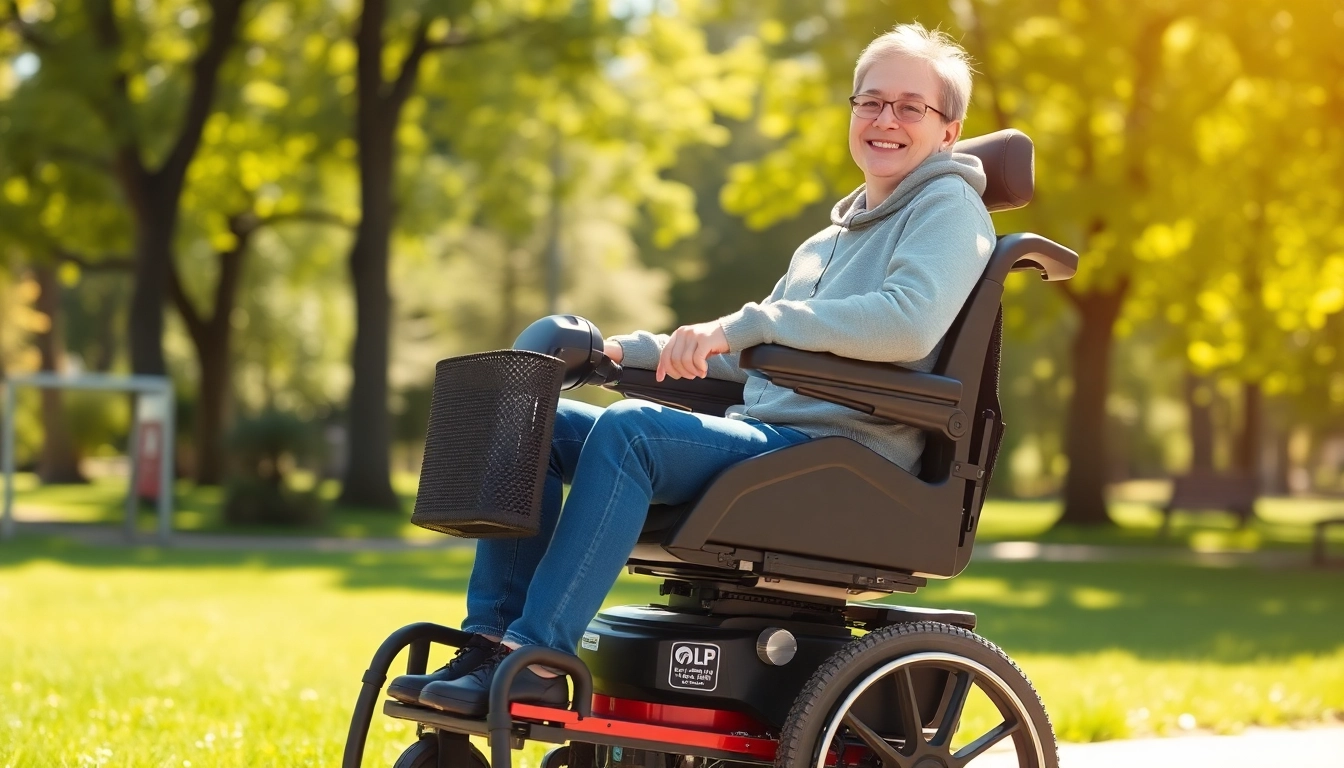Understanding Power Wheelchairs
What is a Power Wheelchair?
A power wheelchair, often referred to as an electric wheelchair, is a type of mobility aid driven by an electric motor. Unlike manual wheelchairs, which require physical effort to propel, power wheelchairs are controlled through a joystick or switch, allowing users to navigate effortlessly through various terrains. These innovations have provided millions of individuals with limited mobility a means to access transportation and freedom.
Power wheelchairs come in various styles and configurations to cater to individual needs, preferences, and lifestyles. They can include features such as adjustable seating, customizable speed settings, and various drive controls, making them an invaluable resource for achieving independence. Users can enhance their daily life by being better equipped to handle daily challenges, whether indoors or outdoors. Consider exploring your options for a reliable power wheelchair to boost your mobility.
Key Features of Power Wheelchairs
The design of power wheelchairs integrates several critical features to suit different users’ needs and preferences:
- Control Mechanisms: Users can engage with power wheelchairs through various control options such as joystick controllers, sip-and-puff systems, or touch-sensitive controls. This allows for customized interfacing based on individual physical capabilities.
- Seating Configurations: Many models include adjustable seating options that offer customized comfort and support. This may encompass features such as reclining backrests, elevating leg rests, and customizable seat widths.
- Speed and Range: Electric wheelchairs have varying speed limits and battery ranges that can significantly affect mobility. Users should assess their typical travel distance to find the right model.
- Tilt and Recline Functions: These functionalities provide additional comfort and pressure relief for users who spend extensive time seated.
- Transportability: Some power wheelchairs are designed for easy disassembly and portability, making them ideal for travel.
- Durable Construction: The robustness of the wheelchair frame and materials assures longevity and adaptability to different terrains.
Benefits of Using a Power Wheelchair
Transitioning from traditional mobility devices to power wheelchairs can offer numerous advantages:
- Enhanced Mobility: Users can travel with greater ease and independence, significantly improving their quality of life. The speed and efficiency of electric propulsion allow for increased exploration.
- Reduced Physical Strain: Power wheelchairs alleviate the physical exertion associated with manual wheelchairs, making them suitable for users with limited upper body strength.
- Improved Social Inclusion: Enhanced mobility fosters independence, allowing users to engage with social gatherings, work environments, and recreational activities.
- Customization for Comfort: With adjustable seating and control settings, users can find optimal configurations for their comfort and health needs.
- Terrain Versatility: Many power wheelchairs can traverse diverse landscapes, from smooth indoor surfaces to bumpy outdoor paths, broadening access to various environments.
Choosing the Right Power Wheelchair for Your Needs
Assessing Your Mobility Requirements
Determining your specific mobility requirements is the first step in selecting the perfect power wheelchair. Consider factors such as:
- Your Health Status: Consult healthcare professionals to understand your mobility capabilities and limitations.
- Intended Use: Reflect on where you plan to use your wheelchair most frequently—indoors, outdoors, or both? This will guide the specification needed for stability and speed.
- Weight Capacity: Ensure the wheelchair can safely accommodate your weight and any additional gear.
Comparing Power Wheelchair Models
When comparing different models of power wheelchairs, consider the following criteria:
- Brand Reputation: Research manufacturers and user reviews to gauge reliability and service standards.
- Warranty and Support: Understand the warranty duration and what it covers. User support availability is also essential.
- Features and Functions: Analyze how each model’s features align with your specific needs—balance speed, comfort, and flexibility.
Evaluating Cost and Insurance Options
The cost of power wheelchairs can vary considerably based on brand, features, and specifications. Here’s how to navigate the financial aspect:
- Budget Considerations: Outline a budget earmarked for your mobility equipment, taking into account potential additional costs such as insurance and maintenance.
- Insurance Coverage: Consult with your healthcare provider or insurance company regarding coverage options. Some power wheelchairs may be eligible for reimbursement.
- Payment Plans: Inquire whether retailers offer financing or payment plans that can make financing more manageable.
Maintaining Your Power Wheelchair
Routine Maintenance Tips
Proper maintenance is essential to extend the lifespan of your power wheelchair. Adhering to the following tips can help keep your device in top condition:
- Regular Cleaning: Maintain the wheelchair by routinely cleaning the frame, wheels, and upholstery. Avoid using abrasive materials that could damage the finish.
- Battery Care: Follow manufacturer guidelines for charging and maintaining the battery. Ensure connections are clean and secure.
- Check Tire Condition: Inspect tires for wear and proper inflation to prevent slippage and enhance control.
- Inspect Electronics: Regularly check all control mechanisms and electrical connections to ensure proper functionality.
Troubleshooting Common Issues
Being aware of potential issues can empower you to handle minor malfunctions without requiring immediate professional service:
- Battery Won’t Charge: Check the charger, ensure the battery connection is secure, and inspect for any visible damage.
- Wheelchair Won’t Move: Examine the joystick and drive control; they may be stuck or improperly configured.
- Electronic Malfunctions: If lights or displays malfunction, consult the user manual for reset instructions or error codes.
When to Seek Professional Help
Having knowledge of the appropriate maintenance tasks is beneficial, but not all issues can be managed independently. Seek professional assistance when:
- The battery consistently fails to hold a charge.
- There are persistent performance issues despite troubleshooting.
- Electrical components show signs of damage or malfunction.
Safety Considerations with Power Wheelchairs
Best Practices for Safe Operation
Safety should be a priority when utilizing a power wheelchair. To ensure safe operation, consider adopting these practices:
- Understand Your Controls: Familiarize yourself with all the control functions and settings before operating the wheelchair.
- Practice in Open Areas: Gain confidence and skill in spacious environments before navigating crowded or complicated spaces.
- Observe Traffic Rules: When using pavements or roads, adhere to local traffic laws to ensure your safety and the safety of others.
Understanding Battery Safety
The battery is one of the critical components of a power wheelchair, which requires specific attention to ensure safety:
- Proper Charging: Always use the recommended charger to avoid battery damage. Do not leave the battery connected to the charger beyond the required time.
- A void Extreme Temperatures: Store and operate the wheelchair in environments that maintain stable temperatures to prevent battery breakdown.
- Regular Maintenance Checks: Inspect the battery regularly for signs of corrosion or leakage, and replace it in accordance with the manufacturer’s guidelines.
Adapting to Variable Terrain
Power wheelchairs can traverse a variety of terrains, but adapting to each environment can enhance safety:
- Know Your Model’s Limits: Understand the stability and range of your wheelchair model across different terrains—some may be better suited for uneven ground than others.
- Slow Down on Uneven Surfaces: Always reduce speed when traversing rough terrain to maintain control and balance.
- Utilize Anti-Tipping Technology: Select models that incorporate anti-tipping features or enhanced stability configurations for added safety in rugged conditions.
Comparative Insights: Power vs. Manual Wheelchairs
Pros and Cons of Power Wheelchairs
Understanding both the advantages and disadvantages of power wheelchairs can guide users in selecting the right mobility aid:
- Pros:
- Enhanced mobility with less physical effort.
- Greater range and speed capabilities.
- Support for individuals with limited upper body strength.
- Cons:
- Higher initial cost compared to manual wheelchairs.
- Need for battery maintenance and potential charging limitations.
- Heavier and less portable for transport.
When to Consider a Manual Wheelchair
While power wheelchairs provide significant advantages, there are scenarios where a manual wheelchair may be more appropriate:
- For users who possess adequate upper body strength to propel themselves.
- In environments where simplicity and lightweight design are paramount, such as travel.
- For users with budget constraints or who may not need the complex features of a power wheelchair.
User Experiences and Testimonials
Real-world experiences from users can provide invaluable insights into the practical benefits of power wheelchairs:
For instance, Jane, a long-term wheelchair user, shares her experience with transitioning to a power wheelchair from a manual model: “I found that using a power chair opened up my world. I can now visit friends who live in hilly neighborhoods without fear of fatigue. My confidence has soared knowing I can keep up with the pace of life.”
Such testimonials emphasize the profound impact these mobility aids can have, from enhancing daily routines to fostering social interactions.



